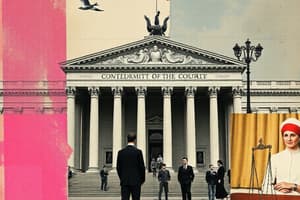Podcast
Questions and Answers
What defense did the defendant interpose?
What defense did the defendant interpose?
The statute of frauds.
What did Justice Brewer observe about the difference between promises?
What did Justice Brewer observe about the difference between promises?
There is a marked difference between a promise that is purely collateral to the obligation of a third party and a promise that is mainly for the benefit of the promisor.
What example is given in the Restatement of Contracts?
What example is given in the Restatement of Contracts?
D owes C $1000 and C is about to levy an attachment on D's factory. S orally promises C that if C forbears to take legal proceedings against D for three months, S will pay D's debt if D fails to do so. S's promise is enforceable.
What category does the case before the court fall into?
What category does the case before the court fall into?
What is the interest of defendant Sugarman in inducing plaintiffs to undertake the work?
What is the interest of defendant Sugarman in inducing plaintiffs to undertake the work?
What is the view of the trial court and the dissenting member of the Appellate Division regarding the consideration?
What is the view of the trial court and the dissenting member of the Appellate Division regarding the consideration?
What judgment is reversed?
What judgment is reversed?
What judgment is reinstated?
What judgment is reinstated?
How many justices voted for reversal?
How many justices voted for reversal?
How many justices voted for affirmance?
How many justices voted for affirmance?
According to Professor Williston, how many different tests have been applied by various courts in determining whether a set of facts falls within the scope of the leading object or main purpose rule?
According to Professor Williston, how many different tests have been applied by various courts in determining whether a set of facts falls within the scope of the leading object or main purpose rule?
What are the two tests that recent cases in this state have relied upon in determining whether a set of facts falls within the scope of the leading object or main purpose rule?
What are the two tests that recent cases in this state have relied upon in determining whether a set of facts falls within the scope of the leading object or main purpose rule?
What is the chief reason for emphasizing the discovery of the leading object and principal purpose of the promisor in applying the 'original-collateral promise' test?
What is the chief reason for emphasizing the discovery of the leading object and principal purpose of the promisor in applying the 'original-collateral promise' test?
What was the purpose of the April 14, 1970 meeting?
What was the purpose of the April 14, 1970 meeting?
What did Mr. Sugarman agree to do at the April 14, 1970 meeting?
What did Mr. Sugarman agree to do at the April 14, 1970 meeting?
What did Mr. Sugarman's letter to Schoor on June 12, 1970 state?
What did Mr. Sugarman's letter to Schoor on June 12, 1970 state?
What are the factual and legal grounds for the defendant's defense in this case?
What are the factual and legal grounds for the defendant's defense in this case?
What was the judgment of the trial judge and the Appellate Division in this case?
What was the judgment of the trial judge and the Appellate Division in this case?
What were the roles and relationships among the parties involved in this case?
What were the roles and relationships among the parties involved in this case?
What is the leading object or main purpose rule?
What is the leading object or main purpose rule?
What factors must the finder of fact examine in applying the leading object or main purpose rule?
What factors must the finder of fact examine in applying the leading object or main purpose rule?
In cases where the original debtor is a corporation in which the promisor has a financial interest, how has the court determined whether the promise falls within the Statute of Frauds?
In cases where the original debtor is a corporation in which the promisor has a financial interest, how has the court determined whether the promise falls within the Statute of Frauds?
What is the leading object or main purpose rule and how does it apply to the case?
What is the leading object or main purpose rule and how does it apply to the case?
What is the leading object or main purpose rule?
What is the leading object or main purpose rule?
What is the significance of the absence of a writing and the fact that the mining company was the principal debtor in defendant's defense?
What is the significance of the absence of a writing and the fact that the mining company was the principal debtor in defendant's defense?
What distinguishes a promise that is purely collateral to the obligation of a third party from one that is mainly for the benefit of the promisor?
What distinguishes a promise that is purely collateral to the obligation of a third party from one that is mainly for the benefit of the promisor?
What example is provided in the Restatement of Contracts to illustrate the enforceability of a promise made by a third party creditor?
What example is provided in the Restatement of Contracts to illustrate the enforceability of a promise made by a third party creditor?
What is the view of the trial court and the dissenting member of the Appellate Division regarding the consideration in the case?
What is the view of the trial court and the dissenting member of the Appellate Division regarding the consideration in the case?
What judgment is reversed and what judgment is reinstated in the case?
What judgment is reversed and what judgment is reinstated in the case?
Flashcards are hidden until you start studying




